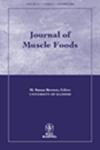COLLAGEN TYPES I AND III IN BOVINE MUSCLES: INFLUENCE OF AGE AND BREED
Abstract
ABSTRACT
Composition and amount of intramuscular connective tissue vary among muscles, age and breed. The purpose of this study was to determine in vivo the proportion of collagen I and III fibers in the Longissimus thoracis (LT) and Gluteus medius (GM) muscles at different ages (6, 12 and 24 months) in the Criolla and Aberdeen Angus bovine breed (24 months) Muscular samples were taken and histological cuts were treated with the picrosirius-red polarization method. The study was performed by light microscope with Polaroid filters and ocular reticulum. Type I fibers between GM and LT muscles, has shown differences only at 12 months old. Regarding Type III fibers, no differences were found between the both muscles at the three ages. When GM muscle was studied, differences were observed in the Type I fibers among the three ages, the major percentage was observed at 24 months. Significant differences were found in Type I as well as Type III fibers in LT at 24 months between Aberdeen Angus and Criolla breeds.
PRACTICAL APPLICATIONS
The variation in proportion of Types I and III collagen in muscles and its relationship to meat texture has been investigated, although results are not conclusive and they are often contradictory. The present inability to elucidate the relationship between phenotypic variations in the intramuscular connective tissue (IMCT) and meat texture is due to our rudimentary understanding of fibril composition.
Investigation of post-mortem treatment of meat to reduce the IMCT contribution to meat toughness has not been completely successful. The knowledge and manipulation in vivo of the proportion and maturity of IMCT may be a possible means of reducing unwanted variability in meat tenderness.
Evaluation of collagen fibers Type I and III by the present histological technique could be used as a potential indicator of meat tenderness.

 求助内容:
求助内容: 应助结果提醒方式:
应助结果提醒方式:


